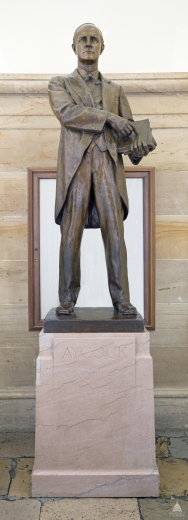
Explore Capitol Hill
Bronze
Given by North Carolina in 1932
Crypt
U.S. Capitol
This statue of Charles Brantley Aycock was given to the National Statuary Hall Collection in the U.S. Capitol by North Carolina in 1932.
Charles Brantley Aycock was born on November 1, 1859, on a farm near Fremont in Wayne County, North Carolina. Though his father died when he was 15, his mother and older brothers recognized his abilities and determined that he should go to college. After graduating from the University of North Carolina in 1880 with first honors in both oratory and essay writing, he entered law practice in Goldsboro and supplemented his income by teaching school. His success in both fields led to his appointment as superintendent of schools for Wayne County and to service on the school board in Goldsboro.
His political career began in 1888 as a presidential elector for Grover Cleveland, when he gained distinction as an orator and political debater. From 1893 to 1897 he served as U.S. attorney for the eastern district of North Carolina, and he was elected governor in 1900. His greatest achievement in office was in education, to which he was dedicated after watching his mother make her mark when signing a deed. He felt that no lasting social reform could be accomplished without education. He supported increased salaries for teachers, longer school terms, and new school buildings; almost 3,000 schools were built during his administration. Other reforms he supported included laws to establish fair election machinery, to prevent lynching, to erect a reformatory for boys, and to restrict child labor.
He resumed his law practice in 1905, but in 1911 he yielded to pressure to seek the Democratic nomination for the U.S. Senate. He died on April 4, 1912, while campaigning.








